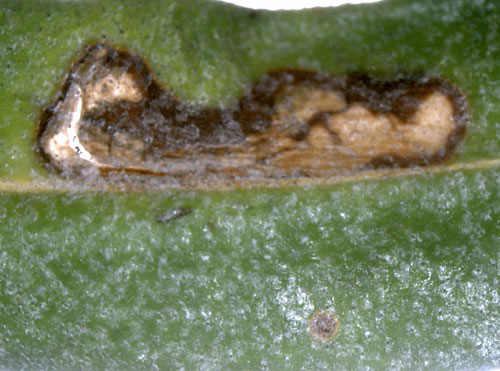|
||||||
|
HIPPOPHAE. Sea-buckthorn. [Elaeagnaceae]
|
|
One species of Hippophae is recorded in Britain, Sea-buckthorn (H. rhamnoides). Three British miners are recorded on Hippophae. A key to the European miners recorded on Hippophae is provided in Bladmineerders van Europa. |
|
Key for the identification of the known mines of British |
1a > Leaf-miner and case-bearer: The larva lives outside the mine, protected by a case, and feeds on the underlying plant tissues via a hole cut in the epidermis. From that point it eats away as much leaf tissue as it can reach without fully entering the mine. Mine does not contain frass (Coleophora species). The larva feeds by inserting its head into small mines it creates on the leaves of birch, elm, alder, or hazel. Occasionally it is found feeding on other trees, or on herbaceous plants onto which it has accidentally Fallén. It forms two cases during its larval life. The first case is initially curved, smooth, laterally compressed with a bivalved anal opening, and about 2 mm long in September. During October it feeds, and adds a few rough collars of larval material around the oral opening. After hibernation, it feeds again in April and early May, adding more protruding collars until they equal or exceed the original smooth part of the case. At the same time, it expands the case girth by the creation of a silk gusset ventrally. The second case, 6 or 7 mm long, is formed in May, leaving the vacated first case attached to its last feeding mine. The new case is tubular with a trivalved crimp at the anal opening. The dorsum is formed from the edge of the leaf from which the case was cut. This results in a more or less serrated dorsal keel, depending on the plant species and the individual piece of leaf used. Considerable variation in the degree of serration can be found, even among specimens off the same tree. The case colour varies with food plant, from yellowish brown on birch, darkening through elm and hazel to dark brown on alder. The strongly curved young case is is a composite leaf case, the adult case is a tubular leaf case. The adult case is bivalved, about 7 mm in length; the mouth angle is around 30°. The case is straw coloured and almost always has a toothed dorsal keel (remnant of the margin of the leaf from which the case was cut). Neither larvae or cases of C. coracipennella, prunifoliae, serratella and spinella can be separated; from serratella. |
|
Coleophora serratella (Linnaeus, 1761) [Lepidoptera: Coleophoridae]. |
1b > Leaf-miner: The frass linear in early gallery, widening to blotch with dispersed frass. Oviposition at random point of the leaf, either at upper- or lower-surface. First a quite slender corridor is made, with a relatively broad, continuous, frass line, that always leaves a clear margin at either side; the corridor winds freely through the leaf. This initial corridor often abruptly changes in direction, widens into a blotch that mostly lie along the leaf margin. Pupation outside the mine. |
|
Stigmella hybnerella (Hübner, 1813) [Lepidoptera: Nepticulidae]. |
1c > Leaf-miner: The young larva lives in a silken tube, open at both ends, on the underside of a leaf. Occasionally one makes an irregular brownish corridor or blotch. How often this happens perhaps differs regionally. Hering (1957a) describes the species as a full blown miner, but Bradley et al (1979a) make no mention of a mining habit, not even facultatively. |
 Mine of Spilonota ocellana Image: © Willem Ellis |
|
Spilonota ocellana (Denis & Schiffermmüller, 1775) [Lepidoptera: Tortricidae]. |
| Last updated 05-Jul-2019 Brian Pitkin | ||
